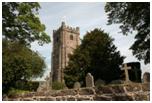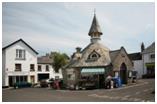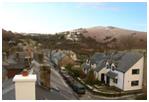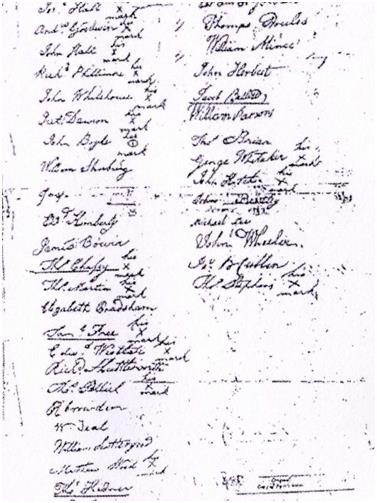They erected tents for shelter and were made to clear the land around the landing spot. They could not possibly imagine where they were.
A small speck of an island, covered in extremely tall pine trees.
In fact 95% of the island was covered with the majestic tall Norfolk Island pine trees.
They were put to work to clear the land and plant crops around the site of the settlement. The area is known as Arthur's Vale.
Today the only occupants at Arthur's Vale are the well fed cows and families of ducks, geese and chickens.
Life on the Island was very difficult. They had to cope with the weather, the guards, the winds, the conditions, and at one stage there was a plot to hijack a boat and row
away. They had no idea that they were virtually trapped on the island. Noah Mortimer was punished with 60 lashes for refusing to work!
The journal written by Phillip Gidley King is well worth reading as it details the events of the day.
One of the benefits for the convict men was that they could chose to marry on the island, mainly because he did not want to encourage any homosexuality and he also
told them that they would be sent back to England if they chose it. That certainly did not happen.
Edward Westlake married Elizabeth Wood, nee Adams, herself a convict.
Colleen McCullough wrote a book about her husband's family, called Morgan's Run. It tells the story of Richard Morgan and others, about their life and times in the First
Settlement it is well worth reading.
A visit to Norfolk Island is a must just to walk in an ancestors footsteps, reflect on the conditions that Edward and Elizabeth and their children all faced.
Imagine trying to walk from their land to Kingston, to have their details recorded, when they were off stores or to attend the Sunday church services.
The land is so hilly, and today there are roads and bridges to cater for the cars, and the cattle have made their own tracks on the hillside.
Life on Norfolk Island for Edward and Elizabeth Westlake
Edward Westlake was selected as one of a founding party of 23 persons to settle Norfolk Island from Port Jackson sailing on the "Supply", 15 Feb 1788, under the
command of Lieut. Philip Gidley King.
King had promised that they could return to England after their sentences were complete.
(There is a new museum on Norfolk Island with information about the First Fleet Convicts, Edward's name is listed on the honour board).
Those people going were:
Jamieson, Surgeon s Mate of the "Sirius"; Mr James Cunningham, Master s Mate of the "Sirius"; Mr T. Altree, Assistant Surgeon; two seamen- Roger Morely & William
Westbrook; two Marines from the "Sirius"-Kerridge & Batchelor; Six female convicts-Elizabeth's Lee, Hipsley & Colley, Olive Gascoin, Ann Inett and Susan Gough; six
male convicts-Charles Mc Lellan, Richard Widdicombe, Edward Garth, Edward Westlake, John Mortimore, Noah Mortimore, Nathaniel Lucas and two other names not
known.
King discovered Lord Howe Island en route and arrived off Norfolk Island on the 28th of February and landed on the island on 6 Mar 1788.
Edward Westlake petitioned Governor Phillip on 28 Sep to allow his family to be sent out to join him. The request was granted but his family did not go to NSW.
Further landings of convicts were made so that by Feb of 1790 there were 149 inhabitants.
In Jul 1791 he was subsisting three persons on a one acre size Sydney town lot with 58 rods cleared. (Sydney town was Kingston)
In Sept 1791 Lt-Gov. King had deemed it necessary to nominate a nightwatch of 21 persons, to patrol several assigned areas. Edward Westlake was one of 5 trusted men
to patrol the Arthur s Vale area, under Captain Hussey, defined "from Capt Paterson s garden to the Governor s garden."
He married Elizabeth Wood (Adams) on 5th November 1791. (In fact they were two of over 100 who were married on the same day)
Records show that on 15 Jan 1793 Westlake was granted 24 acres, (Lot 3) which is about 800 metres east of the wharf at Cascade Bay
He appears to be on the land in 1791, and many official records were not completed until 1796.
He had 2 sows, a cock and six hens, going off stores at once for grain and by May for meat. That meant they were totally reliant on what they grew.
Travel along Stock yard Road turn left into Taries Lane and this road travels over his land grant. Beautiful land, high, level, and with sea views and a water course winding
through.
(His land is high, level, and with views to the water, it is still farmed today)
By Oct 1793 he had cultivated four of his 24 acres, all ploughable, and in June he was living with Elizabeth Wood and three children (Elizabeth had been sent to
Norfolk Island after arriving with the Second Fleet).
In 1794 Edward Westlake was described as a farmer and the occupations of the Norfolk Islanders in Feb 1805 show the three men as settlers and landowners,
and off the stores, as their sentences had expired.
By Mar 1805 he had seven children, all born in the colony plus the daughter that Elizabeth Wood brought with her on the "Neptune". He was a second class settler with
20 acres cultivated and 62 waste, he also owned 36 swine.
Note. In some records his name was spelt Westlick, the phonetic spelling.
Colonial Secretary s Index held at NSW Archives lists :-
"1796, Dec 30 - on list of all grants and leases of land registered in the CSO
In 1806 he was credited 22 pounds ten shillings for the sale of 15 full grown sheep.
In Aug 1807 he is recorded as holding 82 acres, 15 in grain and 67 pasture, with 21 sheep, 36 hogs and 100 bushels of maize in hand.
Leaving Norfolk Island on the "City of Edinburgh" 1808
When it was decided to disband the settlement five vessels were used over a period of six years to transport the inhabitants of Norfolk Island to Van Diemen s Land..
William Maum in a letter he wrote to a friend about the trip on the "Porpoise":-
"We arrived here in safety after a most favourable passage of 19 days (ship records say it took 23 days). We encountered no storms and the sea was so smooth that an
open boat might safely come the same voyage, which was a happy circumstance considering the great number packed and stored on board, whose situation would be
deplorable had we encountered bad weather.....On our arrival here the settlers and others were billeted on the inhabitants of this town, which is far larger than you
could suppose. The houses in general are lath and plaster, and immoderately dear, as a house equal in size to your workshop, of such bad materials, would bring you 50
pounds."
The "City of Edinburgh" was chartered to move the Norfolk Islanders. She sailed from there on 9 Sep 1808 and arrived at Hobart Town 2 Oct 1808.
Among those on board was Edward Westlake, his wife and six children. He had left behind buildings valued at 22 pounds plus 82 acres and was to receive 105 acres at
Roache s Beach, Rokeby (Bellerive or Clarence Plains). The population of Hobart Town in 1808 was 799 persons. (He must have had additional lands on Norfolk Island
than just Lot 3)
Note. In some records his name was spelt Westlick, the phonetic spelling.
Colonial Secretary s Index held at NSW Archives lists :-
1819-1822 On list of persons owing quit rents in VDL, for land at Clarence Plains
25 May 1821- Indebted to the Government at Hobart (Reel 6054; 4/1757 p 64c.)
In 1815 he signed a petition for a Court of Criminal Judicature.
"Hobart Town Gazette" Sat 29 March 1817 : "A List of Settlers who have tendered Wheat for Supply of His Majeftey s Stores, with the Quantity that will be received from
each-- Edw. Weftlake 39 bufhels"
"H.T. Gazette" Sat 14 Feb 1818 under Public Notice: "The under-mentioned Grants of Land are now lying at the Acting Deputy Affiftant Commiffary General s Office for
Delivery on the Fees being paid which are due thereon- Edward Weftlake, 105 acres, 2/2/7d"
The 1818 Muster taken from 7 Sep till 2 Oct, 1818 listed every person in Hobart Town includes Edward Westlake as off the stores.
"H.T.Gazette" 28 Mar 1823 advertised a 60 acre grant for Edward Westlake that would be relinquished if not taken up.
The newspaper records of the day provide an insight into the life and times of the families. In 1827 Samuel Westlake, a sawyer absconded from his employer, he stated
he was sick and never returned! In 1829, Edward Westlake owed 18 shillings to the Government for his 105 acres at Gloucester. He was farming wheat. His partner in
crime Noah Mortimer also owed money for his rent!
Many founding folk were indeed "First Fleeters" as Norfolk Island was founded just a few weeks after Sydney, and Collins likely knew of some individuals from his
earlier days in Sydney. Nine First Fleeters are buried in the Methodist Chapel at Lawitta, New Norfolk.
Notable is Betty King, née Elizabeth Thackery, a first fleet convict girl who married Sam King at New Norfolk on 28 January 1810. The headstone on her well-tended
grave reads, "The first white woman to set foot in Australia" from the First Fleet at Botany Bay.
She is also believed to be the last surviving First Fleeter, male or female, when she died at 90 years of age on 7 August 1856.
Eight other First Fleeters there are Ellen Guy (née Wainright), William Dempsey, William Edmunds, William Foyle, Abraham Hand, Stephen Martin, John Ruglass, and
Edward Westlake.
(Note Edward Westlake was buried in the Old Council Cemetery at New Norfolk, but since 1992 his headstone has not been visible). Was this the same cemetery as Lawitta, or
Magna)







